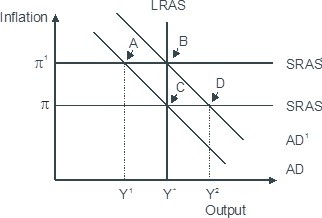Based on the figure below. Starting from long-run equilibrium at point C, a tax cut that increases aggregate demand from AD to AD1 will lead to a short-run equilibrium at point ________ and eventually to a long-run equilibrium at point ________, if left to self-correcting tendencies. 
A. D; C
B. B; C
C. B; A
D. D; B
Answer: D
You might also like to view...
According to economic theory, state governments
A) will be biased toward chronic budget deficits. B) will act in the public interest. C) will act in the national interest. D) will do all of the above. E) will do none of the above.
According to your textbook, Keynesian economic theory
A) argues that federal budget deficits were necessary during periods of rapid economic growth. B) questioned the use of the federal budget deficit as a policy tool to manipulate and fine-tune the economy. C) helped break the mentality that federal budget deficits were improper. D) did all of the above. E) did none of the above.
The revenue that a government raises by printing money is called
A) seignorage. B) monetary revenue. C) currency credit. D) currency inflation.
Economists who are concerned with the effect of fiscal policy on the ability of households and firms to borrow to finance consumption will focus on ________, and economists who want to know whether the government's fiscal policy is sustainable will
focus on ________. A) yearly budget deficits; the federal debt B) the federal debt; yearly budget deficits C) yearly budget deficits; both the federal debt and yearly budget deficits D) the federal debt; both the federal debt and yearly budget deficits